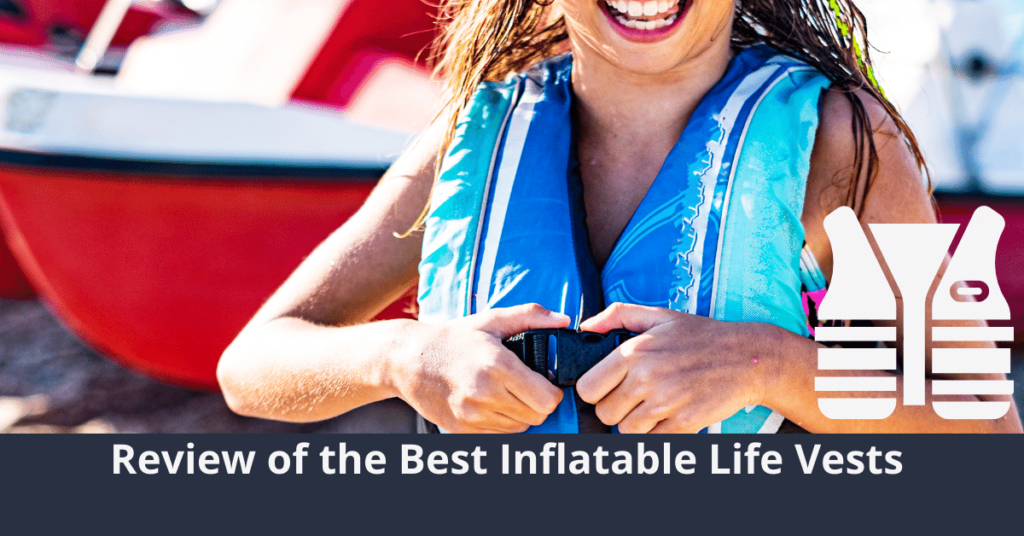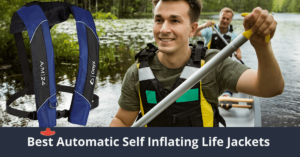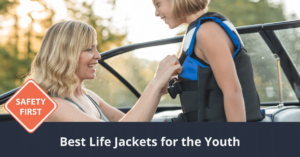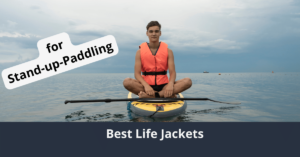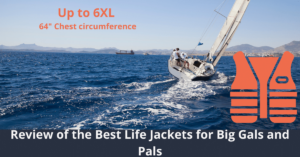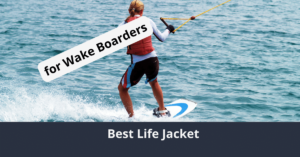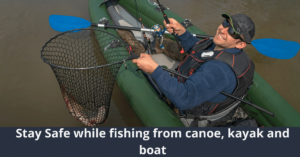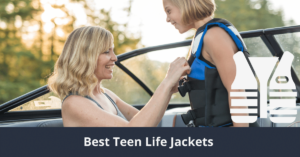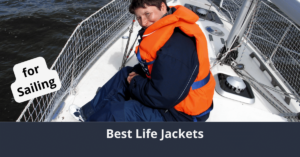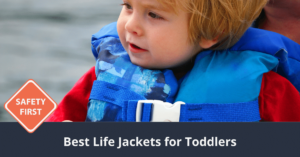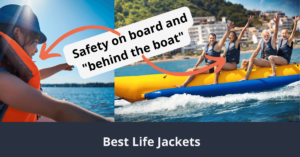If you’re like most people, you probably recognize that life jackets are essential to staying safe. However, there are many details regarding the right inflatable life vest to use for your needs. When you’re looking for the best inflatable life vest, you’ll need to be an informed consumer if you want to keep your head above water.
In this article, we’ll review seven of the best inflatable personal flotation devices on the market. We also explain which features to look for when you want to buy an inflatable life jacket. And lastly, we’ll teach you how to avoid picking weaker personal flotation devices.
If you’re interested in learning more about why inflatable life vests are critical safety tools, our website has an interactive resource depicting US drowning statistics as well as worldwide drowning statistics and drowning prevention.
Without further ado, let’s dive into our inflatable life jacket reviews.
(You might be interested in reading our article on Best Automatic Self Inflating Life Vests
Product Table
Everything you will learn here
- The Best Inflatable Life Jacket Reviews (Updated 2023)
- 1. Onyx A/M-24 Automatic/Manual Inflatable PFD Life Jacket
- 2. Bluestorm Gear Cirrus 26 Automatic/Manual Inflatable PFD Life Jacket for Adults
- 3. Faxpot Adult Inflatable Snorkeling Jacket
- 4. Onyx Unisex Belt Pack Manual Inflatable Life Jacket
- 5. SALVS Automatic/Manual Inflatable Life Jacket
- 6. Bluestorm Gear Stratus 35 Automatic/Manual Inflatable PFD Life Jacket
- 7. Eyson Inflatable Life Jacket
- Inflatable Personal Flotation Device Buyers Guide – (Knowing What To Look For)
- Best Inflatable Life Vest Comparison Chart
- Wrap Up
The Best Inflatable Life Jacket Reviews (Updated 2023)
In this section, we’ll review seven of our top choices for the best inflatable life vests. Each of these vests gets our stamp of approval, and they aren’t listed in order according to any ranking.
1. Onyx A/M-24 Automatic/Manual Inflatable PFD Life Jacket
- U.S. Coast Guard approved Type V life jacket with Type III performance
- Convertible from automatic/manual to manual only inflation
- Low profile design keeps you cool in warm weather
Onyx’ A/M-24 personal flotation device is an industry-leading product thanks to its lightweight and minimalistic design. With the A/M-24, you’ll get a certified type V life jacket with Type III performance for open and calm waters.
Submersion in water automatically activates the vest’s inflator, but you can activate it by breathing into the valve manually or pulling the orange spoon handle.
The only downside of this Onyx inflatable life vest is that it’s a bit uncomfortable to wear on exposed skin. The fabric on the exterior edge of the vest is rough on your inner arm’s flesh, and the nylon belt can cut into your torso.
This means that if you prefer to wear your life vest without anything on underneath, you might want to look elsewhere. On the other hand, if you plan on wearing your life vest with light clothing on, this vest won’t cause you to overheat, making it a great choice for fishing.
Pros:
- Sleek aesthetic
- Doesn’t trap any heat close to your chest
- Comfortable to wear over other garments
- Easy-fit cinch
Cons:
- Nylon strap may dig into bare skin
- The backup oral inflation valve is difficult to access
- Rough edges of the fabric
2. Bluestorm Gear Cirrus 26 Automatic/Manual Inflatable PFD Life Jacket for Adults
- US COAST GUARD-APPROVED TYPE V PFD: This USCG-approved Type 5 life jacket has Type 3 performance. This life vest inflates automatically upon water immersion via a replaceable CO2 cylinder (includes 1 cylinder with purchase) or manually with a pull of the “jerk to inflate” cord or back-up oral inflation tube.
- VERSATILE & COMFORTABLE: Perfect for paddleboarding, fishing, sailing, kayaking, angling, boating, and other water activities. Internal spare CO2 cylinder pocket and accessory attachment point keeps gear secure.
- LIGHTWEIGHT & COOL: This life preserver's ergonomic collar and mesh upper back strap are great for all-day comfort; the mesh back strap helps pull the collar down and away from the neck while the long shell design puts the secure waist belt in a lower, more comfortable position on the body.
Bluestorm Gear’s Cirrus 26 inflatable personal flotation device is a slim and comfortable vest that’s ready for kayaking or fishing expeditions. Unlike other personal flotation devices, the Cirrus 26 has a small pocket for sunglasses, chapstick, and anything else you might want to keep nearby.
The Cirrus 26 is also notable for its comfort. The rear harness fits naturally for most body types, and you won’t need to worry about having broad shoulders. The only downside to the Cirrus 26 is that its buckle is directly in the middle of the stomach region at the bottom of the vest.
This means that the best might feel annoying if you have a large belt. Otherwise, the Cirrus 26 is highly ergonomic and easy to wear.
Pros:
- Great for kayaking
- Includes handy gear pocket
- The comfortable harness fits around the back
- 26 lbs of buoyancy
- Easily replaceable CO2 cylinder
Cons:
- Only one CO2 bottle included
- Center-strap belt may be uncomfortable for some people
- Mediocre aesthetic
3. Faxpot Adult Inflatable Snorkeling Jacket
- ☛【Rrtizan Snorkel Vest】: This inflatable snorkel vest provides enough buoyancy while snorkeling, swimming, kayaking, free diving, boating. And the neon colors provide excellent visibility, great for learners
- ☛【Fast Inflation & Deflation】: Snorkel vests for adults are very easy to operate and use. Put the snorkel vest through the head over the neck, hold the inflation valve, blow into it until it is properly inflated, then release your hand, the valve will automatically close
- ☛【Adjustable Waist & Crotch Straps】: With vertical and horizontal latches, snorkel vests for adults provide a secure and worry-free. Warm Warning: Our snorkel vests are not professional l i f e jackets, and are only for recreational and other no danger involved water activities
While it isn’t technically a life vest, Faxpot’s inflatable snorkeling jacket fulfills many of the same functions. The Faxpot jacket is easy to store, extremely lightweight, and it doesn’t require any CO2 cylinders or other pressurized gas canisters to inflate.
With this vest, you’ll have a high amount of buoyancy in an attractive cyan-colored package. You should be aware that this vest is designed to be used while wearing a wetsuit, however. If you plan on using this vest for fishing or kayaking, you may find that it isn’t the best fit for your needs.
You’ll need to manually inflate the Faxpot vest if you want it to provide any buoyancy. If you’re on the open water, you should inflate the vest before you expect to need it, meaning that you’ll need to grow accustomed to its bulkiness.
Pros:
- Brightly colored
- Supports users up to 220 lbs
- Folds into small footprint when not inflated
- Includes bonus mesh bag for storage
Cons:
- Requires manual inflation
- Uncomfortable waist and crotch strapping
- Traps hot air around chest and neck even when it isn’t inflated
4. Onyx Unisex Belt Pack Manual Inflatable Life Jacket
- U.S. COAST GUARD APPROVED: This USCG-approved inflatable belt pack inflates manually by pulling the inflation handle. Approved for users 16 years or older, and over 80 lbs. The universal size fits up to a 52” waist
- MANUAL INFLATION: The 16 gram CO2 charge provides 17 pounds of buoyancy. This belt pack is equipped with back-up oral inflation to allow the wearer to provide additional buoyancy up to 26.5 pounds
- SAFETY & SECURITY: The inflation handle clips to the life jacket to prevent snag hazards. The adjustable body belt and front buckle closure allows for a secure fit of the vest. Features an attached D-ring for affixing accessories.
Not all personal flotation devices need to be in the form of a vest. Onyx’s Belt Pack is a great example of a personal flotation device in the format of a belt.
With the belt format, the Belt Pack is a very versatile device. You can use it to supplement other flotation devices or in situations where you only need a minimal buoyancy.
If you think your Belt Pack needs more buoyancy than it provides when inflated with the default CO2 canister, you can supplement it with your breath using the built-in tube.
The Belt Pack isn’t a perfect life jacket, however. While it is worn about the waist like a fanny pack, you won’t be able to wear any other pockets or packs at the same time, and the Belt Pack has no storage space of its own.
Pros:
- Can provide more buoyancy with user inflation after CO2 inflation
- Easy to clip to other gear or other life jackets
- Doesn’t inhibit agility
- Doesn’t trap any excess heat
Cons:
- Not sufficient if it’s your only flotation device
- No pockets
- Not compatible with most fanny packs or gear belts
5. SALVS Automatic/Manual Inflatable Life Jacket
When we updated the article, we noticed, that this product is currently not available.
The SALVS Inflatable Life Jacket is a sleek and high-quality personal flotation device that captures an air of luxury despite its powerful performance.
The SALVS jacket is notable for its extra-wide harness straps, soft fabric, and easy rearming. These features mean that you can comfortably wear the vest without any garments underneath.
If you do decide to wear something else underneath the SALVS vest, you’ll find that you’re just as comfortable as you would be otherwise.
The drawbacks of this vest are limited. The 30-day warranty period leaves something to be desired, and the positioning of the CO2 canister after the vest has been inflated could be better.
However, these are only minor concerns, and the SALVS is one of our favorite vests on the market.
Pros:
- Stately aesthetic
- Wide-band harness
- Easy to rearm after use
- Comfortable to wear on bare skin
Cons:
- Short warranty period
- Spent CO2 canister is awkwardly positioned and easy to accidentally knock off when the vest is inflated
- No clips or attachment points for other gear
6. Bluestorm Gear Stratus 35 Automatic/Manual Inflatable PFD Life Jacket
- US COAST GUARD-APPROVED TYPE-II PFD: This USCG-approved Type 2 life jacket inflates automatically upon water immersion via a replaceable CO2 cylinder (includes 1 cylinder with purchase) or manually with a pull of the “jerk to inflate” cord or back-up oral inflation tube.
- LIGHTWEIGHT & COMFORTABLE: Perfect for paddleboarding, fishing, sailing, kayaking, angling, boating, and other water activities. This life vest's ultra-breathable soft polyester collar wicks moisture away from the neck and provides comfort without chaffing; 2” wide waist belt and large adjustment slider ensure a secure, comfortable fit for all-day wear.
- LARGE EASY-ACCESS ZIPPERED FRONT POCKET: Great for storing sunglasses, fishing pliers, licenses, sunscreen during boating, fishing, kayaking, sailing, angling and other on-the-water activities.
Bluestorm’s Gear Stratus 35 life vest is an excellent choice for anyone who wants a highly-buoyant flotation device that they can rely on in turbulent waters. The Stratus 35 has wide straps and a wider-than-average harness loop, meaning that its weight is distributed over a larger surface area.
This means that while the Stratus 35 appears to be larger than many other life vests, you won’t notice the weight as much. When inflated, the Stratus 35 offers 35 lbs of buoyancy, meaning that it’s more buoyant than most of the rapidly inflating personal flotation devices on the market.
The Stratus 35 also has a roomy gear pocket so that you won’t lose track of your stuff. The only issue with the Stratus 35 is that it works best for people whose shoulders are broader than average. If you’re slim in the shoulders, the vest may seem comically large on you.
Pros:
- Durable and comfortable design
- No uncomfortable straps
- Powerful flotation
- Great for people with broad shoulders
- Heavy-duty central buckle
Cons:
- Smaller people may find that the vest is too big
- Some people may find the back harness to be uncomfortable
- Oddly asymmetrical aesthetic
7. Eyson Inflatable Life Jacket
- Fast inflation: Automatically inflates in approximately 5 seconds to adjust your head above the water. Provides comfort and peace of mind for the sportsman, flat water paddler, or recreational boater without knowing you have it on, until you may need it
- Lightweight and durable fabric: Polyester Oxford cover resists tears and punctures but with soft and light weigh. Easy on and easy off design
- Reusable, washable and easy to air dry: Utilize 33 gram CO2 cylinder and bobbin to reuse the life jacket
Eyson’s inflatable life jacket is a great all-around choice thanks to its highly adjustable design. With this vest, you can adjust the positioning of the back harness strap as well as the central belt strap, meaning that you won’t have any issues if you’re taller or shorter than average.
Likewise, the Eyson life vest is great for people who have more gear than average. There are several loops for hanging pouches or other pieces of equipment, and the jacket rides high enough so that they won’t get in the way.
Unfortunately, the adjustable straps on the Eyson jacket might make it uncomfortable for some people. The rear harness strap can dig into your back, and the odd design of the front buckle may be hard for some people to secure properly.
These minor issues mean that the Eyson vest is best for use when you’re active rather than for when you’re sitting in a boat.
Pros:
- Large and exposed reflector strips
- Convenient gear loops
- Highly adjustable to people of different body types
- Easy to wash
Cons:
- Non-standard front buckle design may be confusing for some people
- Uncomfortable rear harness adjustment buckle position
- Reflector stripes may be annoying when the vest isn’t inflated
Inflatable Personal Flotation Device Buyers Guide – (Knowing What To Look For)
Now that you know our top seven picks for the best personal flotation device, it’s time to learn how to be a discerning buyer when you’re shopping for a life vest.
In this section, we’ll go over the features you need to care about when you’re evaluating a life vest, and we’ll also give you a handful of general personal flotation device tips.
Types of Personal Flotation Devices
For consumer use, there are broadly two types of personal flotation devices: non-inflating flotation devices, and inflating flotation devices.
Non-Inflating Devices
Non-inflating devices are what most people traditionally envision as a life vest. Non-inflating devices have foam or cork bricks which are enclosed within a fabric in the shape of a vest or belt.
Non-inflating devices have several advantages. First, they don’t require any CO2 cylinders or breath-based assistance to provide buoyancy. This means that they are less expensive to use throughout multiple periods in the water.
Second, non-inflating buoyancy devices are easier to use. Users only need to buckle the vest to themselves to get the full advantage of its buoyancy.
However, non-inflating devices are always bulkier than their inflatable cousins. This makes them significantly less comfortable to wear for the majority of the time that you aren’t in the water.
(You might be interested in reading the Best Non-Swimmer Life Jackets)
Inflatable Devices
Inflatable devices are made with deflated air pockets that are enclosed in fabric. When the user inflates the vest, or the vest inflates automatically, the air pockets are filled with either CO2 or the ambient air. Then, the air pockets provide buoyancy.
Inflatable devices are more comfortable to wear when outside of the water because they are nearly always much smaller and more lightweight than non-inflatable flotation devices. They’re also typically just as comfortable as their non-inflatable counterparts once you’re in the water.
As far as buoyancy, there’s no meaningful distinction to make between inflatable devices and non-inflatable devices for consumer-grade products. In other words, your inflatable life vest can be just as buoyant as a non-inflatable vest.
This means that, for most purposes, inflatable personal flotation devices are superior to non-inflatable devices.
The biggest disadvantage of inflatable life vests is that they frequently require CO2 cylinders to inflate. Once you inflate the vest once, you will need to purchase another cylinder before the vest can go through another cycle of inflation.
Of course, if you don’t have a spare CO2 cylinder, you can also continue to use the inflated device as a life vest so long as it still has air in its pockets, making it more like a non-inflatable device.
Key Inflatable Life Jacket Features
There are a handful of inflatable life jacket features you should know about because they have a large impact on the comfort and the utility of the flotation device. These features include the strap configuration, manual or automatic inflation, and the vest’s buoyancy.
Strap Configuration and Comfort
The configuration of life vest straps varies from jacket to jacket. Most jackets have a belt section and a harness that reaches around the wearer’s back. The belt section is connected with a buckle either at the center or off to one of the user’s sides.
Some personal flotation devices have more unique strap configurations, with straps reaching between the wearer’s legs, under their arms, or across their chest. In most cases, these alternative configurations are less comfortable than the standard, so plan accordingly.
Likewise, the width of the life jacket’s straps can make a big difference in terms of comfort. Most people will find that wider straps made of softer and more elastic materials will be easier to wear for long periods, especially when worn over bare skin.
Manual or Automatic Inflation
Some inflatable life vests are inflated manually with the pull of a cord. When pulled, the cord triggers the CO2 cylinder to inflate the vest’s air pockets and provide buoyancy. Most inflatable life jackets have a pull-cord as a backup whether or not they are automatic.
Alternatively, other manual inflatable life jackets require the user to breathe into the jacket to inflate the air pockets. Many inflatable life jackets also have a manual inflation tube as a backup whether or not they are automatic.
Automatically inflating life vests have systems which detect when the user has fallen into the water and then inflate the life vest accordingly. These systems can range from saltwater-sensitive fabrics to dissolving pills that uncap the CO2 canister when they are finished dissolving.
Importantly, automatically inflating life vests have a handful of backup methods to manually inflate the vest if the automatic systems fail. This means that automatically inflating vests tend to be safer overall than manually-inflating vests.
However, automatically inflating vests have a substantial downside: they can inflate when the user knows that they do not need additional buoyancy to remain safe in the water.
In other words, if you fall into knee-height water while wearing an automatically inflating life jacket, the jacket will probably inflate, spending the CO2 cylinder within. This means that automatically inflating vests can be a nuisance to keep uninflated leading up to the period when you need them to work.
Buoyancy
The buoyancy of any life jacket is a major concern. If the jacket doesn’t provide buoyancy that is sufficient to keep your head above the water, it might not be enough to save you from drowning.
Life jackets rate their buoyancy in terms of pounds. Many also provide helpful indicators for the maximum weight of the wearer. More buoyancy doesn’t always mean that one jacket is better than another.
In general, the harsher and larger the waters you need your life jacket to work in, you will need more buoyancy. Likewise, the heavier you are, including all of your clothes and equipment, the more buoyancy you’ll need to be safe.
Benefits of Using Automatic Inflatable Life Jackets
Automatic inflatable life jackets are among the most common life jackets on the market because they exist at the nexus of convenience and safety.
There are a handful of benefits you should be aware of when it comes to using an automatic inflatable life vest, including:
- Inflating even when you’re unconscious
- Better safety for children as a result of not requiring judgment about when to inflate the vest
- Having all of the features of manually inflatable vests as backups
These benefits mean that automatic inflatable life jackets are great for everything from sailing to deep-sea fishing. In situations where you won’t be in contact with the water until you’re genuinely in danger, automatic inflatable life jackets provide peace of mind.
While it may be tempting to brush off the fact that automatic inflatable life vests work even when you’re unconscious, for sailing, it’s an important feature. If you get hit in the head and knocked into the water by an unexpectedly traversing boom, an automatic vest will still save you, but a manual vest won’t.
However, there are a few disadvantages associated with automatic inflatable life jackets that you should know about.
Disadvantages of Using Automatic Inflatable Life Jackets
While we’ve already touched on a few of the disadvantages of automatic inflatable life jackets, you should be fully aware of the following points:
- Automatic inflatable life jackets tend to inflate even when you aren’t in danger
- Automatic inflatable life jackets require replacing CO2 cylinders more frequently due to accidental inflations
- Automatic inflatable life jackets are ill-suited for applications like windsurfing where you may be regularly splashed by water
If you plan on using your inflatable life jacket in a situation where you’ll be in contact with the water frequently, even when you aren’t in danger, an automatic vest will be a significant annoyance.
CO2 cylinders aren’t expensive to replace, but it does take a minute or two to remove a spent bottle, deflate the vest, and re-attach a new cylinder after accidental inflation. If you want to rely on your automatic inflatable life vest, you’ll need to keep a supply of extra cylinders on hand.
On the other hand, if you plan to be on a boat or somewhere else where you’re more likely to be completely dry until the moment you fall into the water and are subsequently in danger, automatic inflatable life jackets are a better choice than manual jackets.
(If you want to purchase vests just for boating, you should read: Best Boating Life Vests)
While it’s a minor consideration overall, automatic inflatable life vests also tend to be slightly heavier than their manual equivalents because of the weight of the CO2 cylinder.
More importantly, some people will be able to feel the full CO2 cylinder while the vest is uninflated, so it may make them less comfortable.
Using Your Inflatable Life Vest The Right Way
There are a handful of things you should know to use your inflatable life vest correctly.
First, make sure that the life vest is firmly secured using all of the provided straps and buckles. There shouldn’t be anything extra dangling from your vest that is not attached or cinched to make a close fit.
While it may seem annoying to cinch the vest tightly and secure all of the straps and buckles, the vest needs you to do these things to ensure that it works correctly if you are knocked into the water.
Especially if your vest inflates automatically, if you don’t have your vest secured adequately, you can’t rely on it to keep your head above the water in the way that it is designed.
Second, you shouldn’t tamper with the reflective strips, inflation cylinder, or any other part of the life vest. You may be tempted to remove the reflective strips or replace them, but there isn’t any advantage to doing so.
Likewise, if you tamper with the CO2 cylinder, there is a chance that it will not activate as effectively as it would otherwise when you need the vest to inflate.
Third, check your life vest for any perforations before putting it on. If the air pockets of your life vest are damaged, there’s a chance it won’t be able to inflate at all. Likewise, if the straps are fraying, they may rip when you inflate the vest.
Don’t wear an inflatable personal flotation device if it is damaged. The convenience of using a damaged jacket is nothing in comparison to the risk to your health if you fall into the water.
Maintaining Your Inflatable Life Jacket
Most inflatable life jackets don’t need much maintenance, but there are a few best practices. In general, your inflatable life jacket will maintain itself so long as you keep it stored in a dry and dark place.
If your inflatable life vest can collapse into a small footprint when it isn’t inflated, you should take care not to stack anything on top of the collapsed vest when you store it.
If you stack heavy objects on top of the deflated vest, it may damage the CO2 cylinder valve or other features of the jacket.
You should also make sure that your inflatable life jacket is not wet when you collapse it for storage. If you pack up your life jacket while it is wet, it may grow mold, and the fabric may become damaged.
In the same vein, you should avoid leaving your inflatable life vest submerged in saltwater for long periods. Saltwater is harsh on most materials, and with extended exposure, it may cause the fabric of your vest to deteriorate. The same goes for any chemicals like gasoline or grease.
You don’t necessarily need to clean your inflatable life jacket like you would another garment. If you do want to clean your life vest, you can do so with a gentle soap and warm water solution.
You shouldn’t put your inflatable life vest into the washing machine or the dryer, as it may damage the CO2 canister or the valves.
Life Vest Safety Tips
There are a handful of tips which you should implement to get the most safety out of your inflatable life jacket:
- Avoid wearing your inflatable life jacket in any fashion other than the one suggested by the manufacturer
- Make sure that your inflatable life jacket’s CO2 canister is full before heading out to the water
- Don’t modify your inflatable life jacket in any way
- Don’t hang too much gear on your inflatable life jacket if there are hooks for attaching items
- Ensure everyone in your group understands what type of life jacket they have, inflating it, and how to avoid unintentionally inflating it or deflating it when it isn’t appropriate
- Don’t crush or twist your inflatable life jacket whether or not it is inflated
- Don’t puncture or use sharps around your inflatable life jacket
- Make sure that your inflatable life vest is still under warranty before using it
Aside from these tips, you should also test your inflatable life vest buoyancy relative to your weight in a controlled setting. This means that you should inflate your jacket and submerge yourself in the water. If your head stays above water as a result of the buoyancy of the vest, your vest is a good fit.
On the other hand, if your personal flotation device doesn’t keep your head above calm waters during your test, you’ll need to find a different one with more buoyancy. Remember, in rougher waters, you’ll need a higher amount of buoyancy to stay comfortable if you fall in.
On that note, you should also ensure that your personal flotation device is balanced such that it keeps your head facing above the water even if the vest is inflated when your head is facing down into the water.
Most inflatable life vests are balanced so that you can right yourself very quickly once the vest is inflated. If you find that during your test, it is difficult to right yourself from a face-down swimming position when the vest is inflated, you should find another vest or adjust your vest.
The point of the self-righting balance of inflatable personal flotation devices is that it will keep your head above the water even when you are unconscious. So, if the vest isn’t balanced correctly, you can’t count on it to keep you safe.
Best Inflatable Life Vest Comparison Chart
| Product Name | Price | Size (LxW) | Safety | Unique Features |
|---|---|---|---|---|
| Onyx A/M-24 Automatic/Manual Inflatable PFD Life Jacket | $-$$ | 22.00''x13.50'' | US Coast Guard Approved Type V | Doesn•t trap any heat close to your chest |
| Bluestorm Gear Cirrus 26 Automatic/Manual Inflatable PFD Life Jacket for Adults | $ | 18''x12'' | US Coast Guard Approved TYPE-V With TYPE-III | Easily replaceable CO2 cylinder |
| Faxpot Adult Inflatable Snorkeling Jacket | $ | 20.46''x15.75'' | Latch straps secures vertically and horizontally, easy pinch buckles for fast removal | Folds into small footprint when not inflated |
| Onyx Unisex Belt Pack Manual Inflatable Life Jacket | $ | 11''x8'' | US Coast Guard Approved | Provide buoyancy with user inflation after CO2 inflation |
| SALVS Automatic/Manual Inflatable Life Jacket | $ | 23''x16'' | Automatic or Manual, full mobility safety | Comfortable to wear on bare skin, Easy to rearm after use |
| Bluestorm Gear Stratus 35 Automatic/Manual Inflatable PFD Life Jacket | $-$$ | 17''x14'' | US Coast Guard Approved TYPE-II | Great for people with broad shoulders, Heavy-duty central buckle |
| Eyson Inflatable Life Jacket | $ | 20''x11.8'' | CE Certificated & SOLAS Approved 3M Reflectors | Reusable, washable and easy to air dry |
Wrap Up
That concludes our review of the seven best inflatable personal flotation devices. We hope you’ve learned something about the features to look for in a life jacket and the major differences between automatic and manually-inflating life vests.
Remember to make your life jacket choice carefully. If you pick the right life vest, you could be saving your life down the road. On the other hand, if you choose the wrong PFD for your needs, it could let you down when you need it the most.
Last update on 2025-04-30 / Affiliate links / Images from Amazon Product Advertising API

